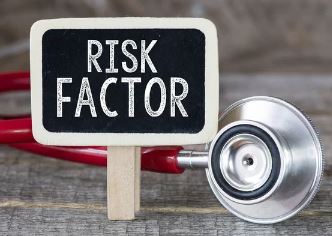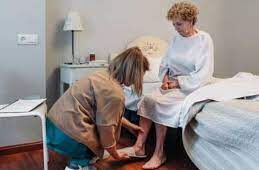Osteoporosis, a bone-weakening disorder, can shatter more than just bones—it can break the freedom to move and live independently. The risk of fractures, particularly in the hip and spine, becomes a pressing concern for older adults. The question then arises: How can you lower your risk of these debilitating injuries?
Symptoms
There are often no symptoms in the early stages of the development of osteoporosis. Once there is a significant loss in bone mass, symptoms may include bone fractures that occur with little impact, a change posture and a loss in height. The most significant complication of osteoporosis is the increased fracture risk.
Identifying the Risks: Early Detection is Key
Certain medical conditions pave the way for osteoporosis, making early detection crucial. If you fall into any of the following categories, it’s essential to seek assessment from your healthcare provider, undergo a bone density test, and initiate early intervention:

- Age: Individuals older than 65 years
- Family History: If a parent has a history of hip fracture
- Lifestyle Factors: Smoking or excessive alcohol consumption
- Low Body Weight: Below 60 kg
Beyond these general risk factors, additional considerations include:
- Hormonal Factors: Premature menopause (before 45 years), hyperthyroidism, or kidney disease
- Medical Conditions: Gastric surgery, bariatric surgery, malabsorption syndrome, rheumatoid arthritis, or multiple myelomas
Surprising Medications Linked to Osteoporosis: Are You at Risk?

Certain medications, both prescription and over-the-counter, may have an unexpected impact on your bone health
Blood Thinners
- Lovenox® (heparins)
- Fragmin® (heparins)
- Innohep® (heparins)
- Coumadin® (warfarin)
Antiseizure Medications:
- Depakene® (valproic acid)
Breast Cancer Medications:
- Arimidex® (anastrozole)
- Femara® (letrozole)
Corticosteroids (Prolonged use more than 3 months)
Water Pills:
- Lasix® (furosemide)
- Edecrin® (ethacrynic acid)
Acid Suppressants:
- Esomeprazole (Nexium®)
- Lansoprazole (Prevacid®)
- Omeprazole (Losec®)
- Pantoprazole (Pantoloc®, Tecta®)
- Rabeprazole (Pariet®)
Antidiabetic Medications:
- Actos® (Pioglitazone)
- Avandia® (Rosiglitazone)
Antidepressants:
- Celexa® (Citalopram)
- Cipralex® (Escitalopram)
- Prozac® (Fluoxetine)
- Luvox® (Fluvoxamine)
- Paxil® (Paroxetine)
- Zoloft® (Sertraline)
High-Dose Vitamin A


Building Strong Bones: A Diet Guide for Osteoporosis Prevention
Maintaining optimal bone health is crucial for a vibrant and active lifestyle, and your diet plays a pivotal role in achieving this. Whether you’re looking to prevent osteoporosis or support overall bone strength, adopting a balanced and nutrient-rich diet is key. Here are some recommendations to help you build and maintain strong bones.
Kick the Habit: Quit Smoking
- First and foremost, if you’re a smoker, it’s time to quit. Smoking not only poses a myriad of health risks but also has a detrimental effect on bone health. The chemicals in cigarettes can interfere with the body’s ability to absorb calcium, an essential mineral for bone strength.
Prioritize Protein Intake
- Include an adequate amount of protein in your diet to support the maintenance and repair of bones. Sources such as lean meats, poultry, fish, dairy products, legumes, and nuts can provide the protein your body needs to keep bones strong and resilient.
Moderate Alcohol and Caffeine Consumption
- While the occasional glass of wine or cup of coffee is acceptable, excessive alcohol and caffeine intake can contribute to bone loss. Limit alcohol consumption to no more than two drinks per day and caffeine intake to four cups or fewer daily to promote optimal bone health.
Harness the Power of Vitamin D
- Vitamin D is crucial for calcium absorption, a process vital for bone strength. Aim for 800–2000 units of vitamin D per day through sources like fatty fish, fortified dairy products, and sensible sun exposure. However, be cautious not to exceed 4000 units per day, as excessive intake can have adverse effects.
Calcium Counts: Know Your Intake
- Calcium is a cornerstone for bone health, and meeting your daily requirements is essential. For women under 50, aim for 1000mg of calcium per day, while those aged 50 and older should target 1200mg daily. Incorporate calcium-rich foods into your diet, such as milk, dairy products, eggs, leafy greens, and fish like sardines.

Maintaining bone health is a critical aspect of overall well-being, and for individuals with osteoporosis, a customized approach to exercise becomes paramount. The benefits of incorporating a well-designed exercise routine include increased muscle strength, improved balance, reduced risk of fractures, enhanced posture, and relief from pain.
Benefits of Exercise
Engaging in regular exercise can offer a multitude of advantages for individuals with osteoporosis. Not only does it increase muscle strength, but it also enhances balance, reducing the likelihood of falls and subsequent fractures. Additionally, a well-rounded exercise regimen contributes to better posture and alleviates discomfort associated with osteoporosis.
Choosing the Right Exercise
Strength Training
For building bone strength, focusing on activities that involve resistance is crucial. Incorporating weightlifting, resistance band exercises, or yoga into your routine helps maintain robust muscles and prevents bone loss. Particularly for those with osteoporosis, targeting upper back muscles is beneficial for posture improvement and supporting bone density.
Aerobic Activity
While aerobic activities such as dancing, biking, or mowing the lawn contribute to overall health, they lack the weight-bearing load necessary to combat bone loss. To address this, individuals should consider supplementing their routine with weight-bearing exercises for a comprehensive approach.
Flexibility and Balance Exercises
In addition to strength and aerobic exercises, it’s vital to include flexibility and balance training in your regimen. Activities like swimming and cycling offer various benefits but may fall short in terms of bone density improvement. Therefore, incorporating weight-bearing exercises becomes essential for a well-rounded exercise program.
Muscle-strengthening activities build
up your muscles.
With bone-strengthening activities,
your muscles push and pull against
your bones. This helps make your bones
stronger.
- Examples of muscle-strengthening
activities include climbing stairs,
digging in the garden, lifting weights,
push-ups and curl-ups. - Examples of bone-strengthening activities
include yoga, walking and running.
Moderate-intensity aerobic activity
makes you breathe harder and your heart
beat faster. You should be able to talk,
but not sing.
- Examples of vigorous activity include
jogging or cross-country skiing.
Vigorous-intensity aerobic activity
makes your heart rate increase quite a
bit and you won’t be able to say more
than a few words without needing to
catch your breath.
- Examples of moderate activity include
walking quickly or bike riding.
Flexibility Exercises
Maintaining joint mobility is crucial for muscle function. Gentle stretches, especially after a warm-up, contribute to supple muscles and efficient movement.
Stability and Balance Exercises
To mitigate the risk of falls, stability and balance exercises play a pivotal role. Simple activities like standing on one leg or participating in practices like tai chi enhance muscle coordination and balance.
Movements to Avoid
Certain exercises should be approached with caution or avoided altogether. High-impact activities such as jumping or running, as well as jerky movements, pose a risk of fractures. Similarly, bending and twisting at the waist, seen in activities like touching your toes or sit-ups, should be avoided to prevent potential spinal injuries.
Discover safe and effective exercises for osteoporosis with Osteoporosis Canada’s video series. Tailored to guide individuals through beneficial exercises, this comprehensive resource provides visual demonstrations and detailed instructions for maintaining bone health.










